Power Module Packaging Market Size
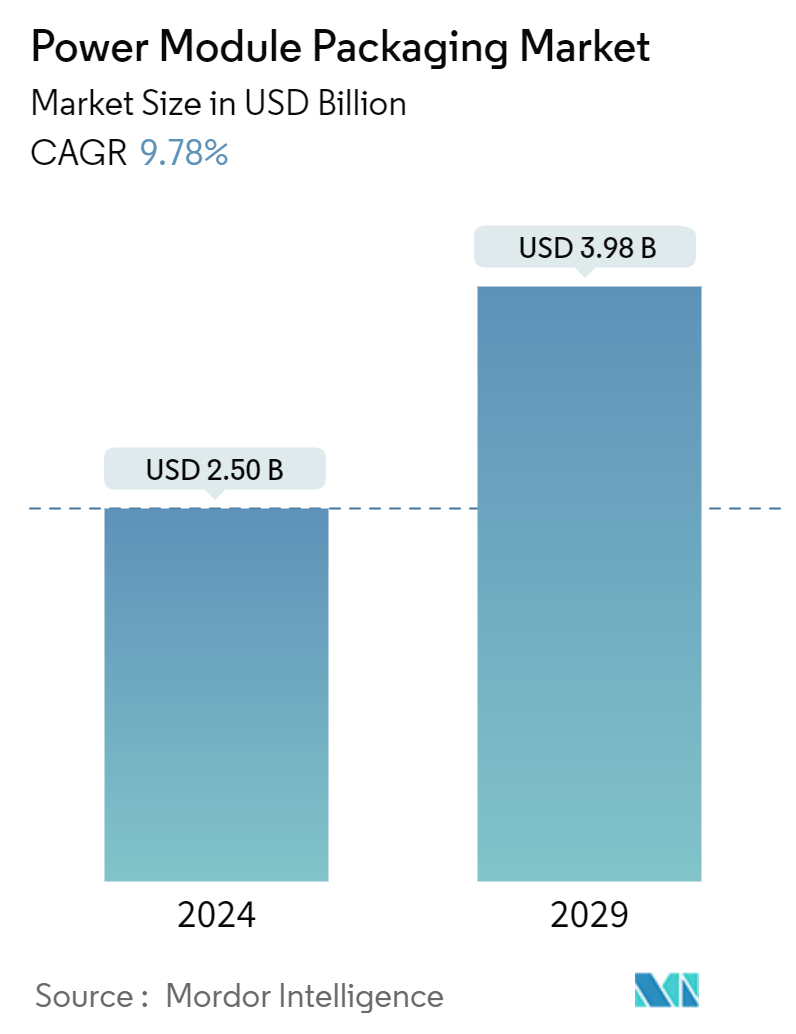
| Study Period | 2019 - 2029 |
| Market Size (2024) | USD 2.5 Billion |
| Market Size (2029) | USD 3.98 Billion |
| CAGR (2024 - 2029) | 9.78 % |
| Fastest Growing Market | Asia Pacific |
| Largest Market | Asia Pacific |
Major Players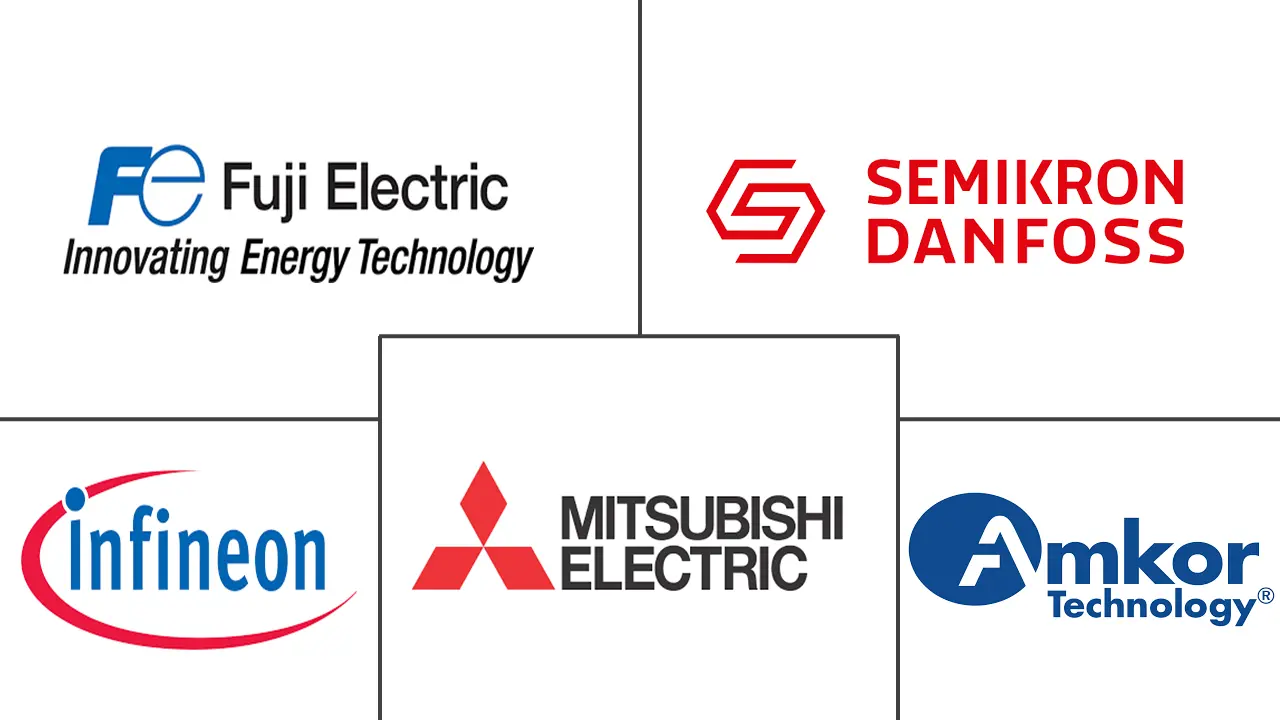
*Disclaimer: Major Players sorted in no particular order |
Power Module Packaging Market Analysis
The Power Module Packaging Market size is estimated at USD 2.50 billion in 2024, and is expected to reach USD 3.98 billion by 2029, at a CAGR of 9.78% during the forecast period (2024-2029).
A power electronic module or power module acts as a physical container for storing several power components, usually power semiconductor devices. Packaging plays a crucial role in the shift toward higher power densities, which enables more efficient power supplies, faster conversion, power delivery, and improved reliability. As the world is shifting toward faster-switching frequencies and higher power densities, there is a related shift in packaging materials used for wire bonding, die-attach, substrates, and system cooling.
- The power modules are the key elements in the power inverters and converters. Power modules are commonly used in electric cars and other electric motor controllers, appliances, power supplies, electroplating machinery, medical equipment, battery chargers, AC to DC inverters and converters, power switches, and welding equipment. The power module packaging market's growth is driven by a reduction in the wastage of energy, the use of efficient distributed cooling schemes, a reduction in footprint, and a consequent increase in power density. Moreover, the growing demand for power modules in the industrial and consumer electronics sector is set to drive the power module packaging market.
- The consumer electronics industry has experienced a significant transformation driven by the rising demand for smarter and more advanced devices. Another important trend in the electronics industry is the increase of the Internet of Things (IoT). With the rise in demand for smart devices, IoT has become essential to everyday life. Thus, businesses primarily use this technology to develop new products and services. For instance, according to GSMA, greater China leads significantly with 1.5 billion connections, surpassing other regions, and is followed by North America and Europe with 0.3 billion connections each.
- Industrial appliances such as uninterruptible power supplies (UPS), server power supplies, power converters, and motor drives consume a significant portion of the world's power. Therefore, any increase in efficiency in industrial power supplies will substantially reduce a company's operating costs. With greater power density and better thermal performance, the demand for high-efficiency power supplies is increasing exponentially.
- The consolidation will increase as power module manufacturers grapple with the increasing complexity, the loss of a roadmap for future designs as Moore's Law is becoming more difficult and expensive to sustain, and a flood of new markets with evolving standards and different sets of rules.
- The Russia and Ukraine War is driving the aluminum and nickel prices upward, while high energy prices have affected metals, specifically copper. Copper is a crucial material in the power module packaging market, and it is used in baseplate and electrical interconnections. Copper price fluctuations will directly impact the power module packaging market. Metal prices were expected to increase 16% in 2022 and ease somewhat in 2023, according to ukraineinvest.gov. The ongoing war between Russia and Ukraine, stricter emissions standards in China, and high energy costs are the main factors in the increasing shortage of copper.
Power Module Packaging Market Trends
Interconnections Holds Major Share
- The power modules are the key elements in the power inverters and converters. Power modules are commonly used in electric cars and other electric motor controllers, appliances, power supplies, electroplating machinery, medical equipment, battery chargers, AC to DC inverters and converters, power switches, and welding equipment. The power module packaging market’s growth is driven by a reduction in the wastage of energy, the use of efficient distributed cooling schemes, a reduction in footprint, and a consequent increase in power density.
- Interconnects are used to establish connections between different active and passive components within an electronic assembly that manages a system. Connectors are commonly utilized in telecommunications and consumer electronics applications, such as smartphones, laptops, computers, and TVs, and are driving the demand for innovative and advanced power module packaging solutions. For instance, as per GSMA, in 2023, the smartphone adoption rate across the Asia-Pacific region reached 78%. By 2030, smartphone adoption in APAC is projected to reach over 90%, which would drive the market growth.
- It is important to note that interconnection technology is a critical and necessary part of packaging. Chips are interconnected through packaging to receive power, exchange signals, and, ultimately, operate. As a semiconductor product's speed, density, and functions change depending on how the interconnection is made, interconnection methods constantly evolve and develop.
- Typically, power devices in a power module are interconnected using wire bonds for electrical connection and filled with silicone gel for insulation. Technologies such as large-diameter copper wire bonds, silver sintering, wirebondless interconnects, and planar flex-based packaging to improve the parasitic inductance and resistance, temperature capability, reliability, and thermal performance of new comprehensive band gap power modules have been implemented to varying degrees of success.
- Interconnections can be explained by the lifetime of a chip connection, which is mainly limited by active power cycles. The solder is sandwiched between the chip and substrate and can expand only in the Z-direction during active heating. This leads to fatigue of the solder body. Silver sintering, which is the transformation of a loose metal powder into a firmly bonded porous structure, has been introduced to extend the power cycling capability. Further, the interconnect is formed by sintering the smallest sphere-like particles, activated at low temperatures.
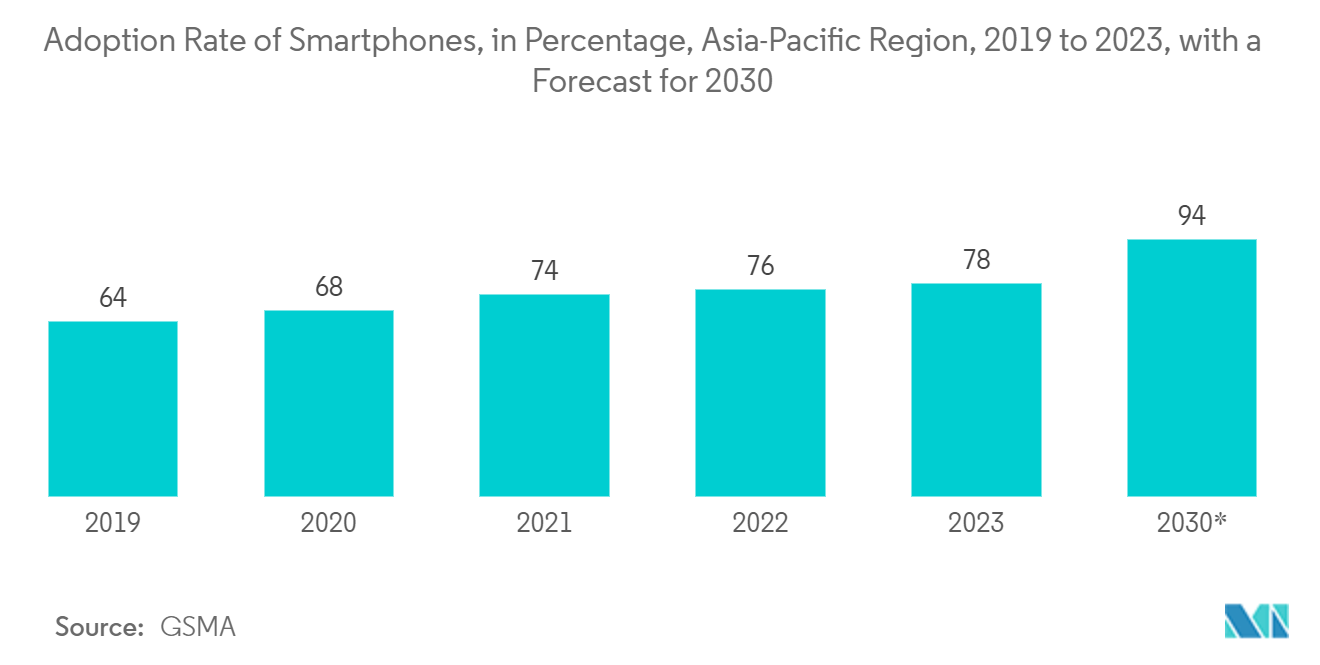
Asia-Pacific is Expected to Witness Major Growth
- The region is expected to occupy the highest share, owing to the increasing adoption of renewable energy and the rising number of electric/hybrid vehicles in countries like China. China has emerged as a dominant force in the renewable energy stage. The Chinese government has made significant strides in beginning a historic shift away from coal. Over the last decade, according to China's National Bureau of Statistics, coal's share of energy consumption decreased from 68.5% to 56%.
- The government is pushing for emissions reductions and improved air quality. According to Global Energy Monitor, China’s solar capacity is 228 gigawatts (GW), with wind capacity at a whopping 310 GW more than the rest of the world combined. China aims to hit its 2030 target of 1,200 GW, with another 750 GW of new wind and solar projects in the pipeline.
- India’s ambitious renewable energy goals are transforming its power sector. Renewable electricity is growing faster in India, and the new capacity additions are expected to double by 2026. As more efficient batteries will be used to store electricity, which will further reduce the cost of solar energy by 66% compared to the current price, renewable energy is expected to make up around 49% of total electricity generation by 2040.
- The Indian government's commitment to achieving net zero emissions by 2070 and increasing its renewable energy target to 500 GW by 2030 at the COP26 Summit has significantly contributed to industry growth. The government is taking several initiatives to boost India's renewable energy sector.
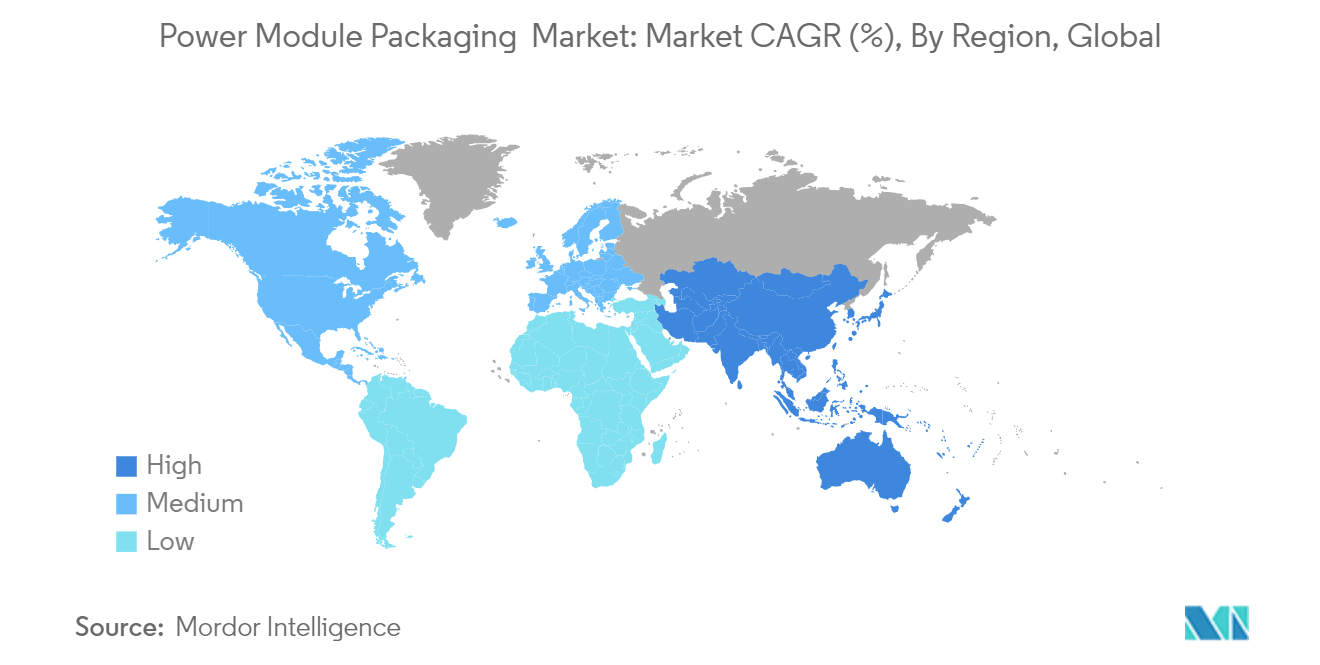
Power Module Packaging Industry Overview
The power module packaging market is semi-consolidated, with the presence of major players such as Fuji Electric Co. Ltd, Infineon Technologies AG, Mitsubishi Electric Corporation (Powerex Inc.), Semikron, and Amkor Technology Inc. These players in the market are adopting strategies such as partnerships and acquisitions to enhance their product offerings and gain sustainable competitive advantage.
With the growing consolidation, technological advancement, and geopolitical scenarios, the market studied has been witnessing fluctuation. In addition, with the increasing vertical integration of foundries and IDMs, the intensity of competition in the market studied is expected to continue to rise, considering players’ ability to invest, which results from their revenues.
In a market where the sustainable competitive advantage through innovation is significant, competition will only increase, given the anticipated surge in demand from end-user industries such as automotive.
In such a scenario, the brand identity plays a major role, considering the importance of packaging quality that the end users expect from the player. With the presence of large market incumbents, such as Fuji Electric, Mitsubishi, AMKOR, Onsemi, and Semikron, the market penetration levels are also high.
Power Module Packaging Market Leaders
-
Fuji Electric Co. Ltd
-
Infineon Technologies AG
-
Mitsubishi Electric Corporation (Powerex Inc.)
-
Semikron
-
Amkor Technology Inc.
*Disclaimer: Major Players sorted in no particular order
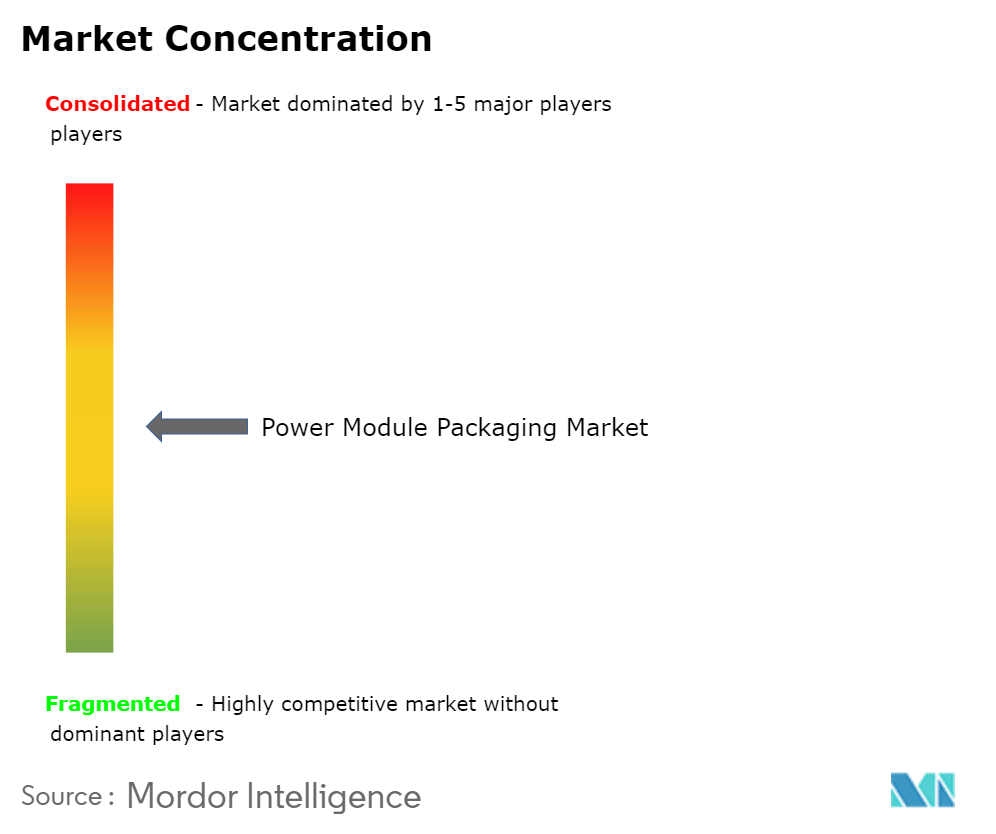
Power Module Packaging Market News
- December 2023: Infineon Technologies AG launched the 4.5 kV XHP 3 IGBT modules in response to the global push for downsizing and integration. The 4.5 kV XHP will fundamentally change the landscape for medium voltage drives (MVD) and transportation applications operating at 2000 to 3300 V AC in 2- and 3-level topologies.
- December 2023: STMicroelectronics announced that it had signed a long-term silicon carbide (SiC) supply agreement with Li Auto. Under this agreement, STMicroelectronics would provide Li Auto with SiC MOSFET devices to support Li Auto’s strategy around high-voltage battery electric vehicles (BEVs) in various market segments.
Power Module Packaging Market Report - Table of Contents
1. INTRODUCTION
- 1.1 Study Assumptions and Market Definition
- 1.2 Scope of the Study
2. RESEARCH METHODOLOGY
3. EXECUTIVE SUMMARY
4. MARKET INSIGHT
- 4.1 Market Overview
-
4.2 Industry Attractiveness - Porter's Five Forces Analysis
- 4.2.1 Threat of New Entrants
- 4.2.2 Bargaining Power of Buyers
- 4.2.3 Bargaining Power of Suppliers
- 4.2.4 Threat of Substitute Products and Services
- 4.2.5 Intensity of Competitive Rivalry
- 4.3 Assessment of the Impact of COVID-19 and Macroeconomic Trends on the Industry
- 4.4 Technology Snapshot
5. MARKET DYNAMICS
-
5.1 Market Drivers
- 5.1.1 Increasing Demand from the Industrial and Consumer Electronics Segment
- 5.1.2 Rising Demand for Energy-efficient Devices
-
5.2 Market Restraints
- 5.2.1 Market Consolidation Affecting Overall Profitability
6. MARKET SEGMENTATION
-
6.1 By Technology
- 6.1.1 Substrate
- 6.1.2 Baseplate
- 6.1.3 Die Attach
- 6.1.4 Substrate Attach
- 6.1.5 Encapsulations
- 6.1.6 Interconnections
- 6.1.7 Other Technologies
-
6.2 By Geography***
- 6.2.1 North America
- 6.2.2 Europe
- 6.2.3 Asia
- 6.2.4 Australia and New Zealand
- 6.2.5 Latin America
- 6.2.6 Middle East and Africa
7. COMPETITIVE LANDSCAPE
-
7.1 Company Profiles
- 7.1.1 Fuji Electric Co. Ltd
- 7.1.2 Infineon Technologies AG
- 7.1.3 Mitsubishi Electric Corporation (Powerex Inc.)
- 7.1.4 Semikron
- 7.1.5 Amkor Technology Inc.
- 7.1.6 Hitachi Ltd
- 7.1.7 STMicroelectronics NV
- 7.1.8 MacMic Science & Technology Co. Ltd
- 7.1.9 Texas Instruments Inc.
- 7.1.10 Starpower Semiconductor Ltd
- 7.1.11 Toshiba Corporation
- *List Not Exhaustive
8. INVESTMENT ANALYSIS
9. FUTURE OF THE MARKET
** Subject To AvailablityPower Module Packaging Industry Segmentation
A power module or power electronic module acts as a physical container for the storage of several power components, usually power semiconductor devices. The market growth is driven by a reduction in energy wastage, the use of efficient distributed cooling schemes, a reduction in footprint, and a consequent increase in power density. Moreover, the growing demand for power modules in the industrial and consumer electronics sectors is likely to drive the growth of the power module packaging market.
The power module packaging market is segmented by technology (substrate, baseplate, die-attach, substrate attach, encapsulations, interconnections, and other technologies) and geography (North America, Europe, Asia-Pacific, and the Rest of the World). The market sizes and forecasts are provided in terms of value in USD for all the above segments.
| By Technology | Substrate |
| Baseplate | |
| Die Attach | |
| Substrate Attach | |
| Encapsulations | |
| Interconnections | |
| Other Technologies | |
| By Geography*** | North America |
| Europe | |
| Asia | |
| Australia and New Zealand | |
| Latin America | |
| Middle East and Africa |
Power Module Packaging Market Research FAQs
How big is the Power Module Packaging Market?
The Power Module Packaging Market size is expected to reach USD 2.5 billion in 2024 and grow at a CAGR of 9.78% to reach USD 3.98 billion by 2029.
What is the current Power Module Packaging Market size?
In 2024, the Power Module Packaging Market size is expected to reach USD 2.5 billion.
Who are the key players in Power Module Packaging Market?
Fuji Electric Co. Ltd, Infineon Technologies AG, Mitsubishi Electric Corporation (Powerex Inc.), Semikron and Amkor Technology Inc. are the major companies operating in the Power Module Packaging Market.
Which is the fastest growing region in Power Module Packaging Market?
Asia Pacific is estimated to grow at the highest CAGR over the forecast period (2024-2029).
Which region has the biggest share in Power Module Packaging Market?
In 2024, the Asia Pacific accounts for the largest market share in Power Module Packaging Market.
What years does this Power Module Packaging Market cover, and what was the market size in 2023?
In 2023, the Power Module Packaging Market size was estimated at USD 2.26 billion. The report covers the Power Module Packaging Market historical market size for years: 2019, 2020, 2021, 2022 and 2023. The report also forecasts the Power Module Packaging Market size for years: 2024, 2025, 2026, 2027, 2028 and 2029.
Power Module Packaging Industry Report
Statistics for the 2024 Power Module Packaging market share, size and revenue growth rate, created by Mordor Intelligence™ Industry Reports. Power Module Packaging analysis includes a market forecast outlook to 2029 and historical overview. Get a sample of this industry analysis as a free report PDF download.



